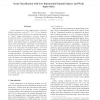Free Online Productivity Tools
i2Speak
i2Symbol
i2OCR
iTex2Img
iWeb2Print
iWeb2Shot
i2Type
iPdf2Split
iPdf2Merge
i2Bopomofo
i2Arabic
i2Style
i2Image
i2PDF
iLatex2Rtf
Sci2ools
CVPR
2008
IEEE
2008
IEEE
Scene classification with low-dimensional semantic spaces and weak supervision
A novel approach to scene categorization is proposed. Similar to previous works of [11, 15, 3, 12], we introduce an intermediate space, based on a low dimensional semantic "theme" image representation. However, instead of learning the themes in an unsupervised manner, they are learned with weak supervision, from casual image annotations. Each theme induces a probability density on the space of low-level features, and images are represented as vectors of posterior theme probabilities. This enables an image to be associated with multiple themes, even when there are no multiple associations in the training labels. An implementation is presented and compared to various existing algorithms, on benchmark datasets. It is shown that the proposed low dimensional representation correlates well with human scene understanding, and is able to learn theme co-occurrences without explicit training. It is also shown to outperform unsupervised latent-space methods, with much smaller training ...
Casual Image Annotations | Computer Vision | CVPR 2008 | Low Dimensional Representation | Posterior Theme Probabilities | Theme Co-occurrences | Theme Space |
| Added | 12 Oct 2009 |
| Updated | 12 Oct 2009 |
| Type | Conference |
| Year | 2008 |
| Where | CVPR |
| Authors | Nikhil Rasiwasia, Nuno Vasconcelos |
Comments (0)

